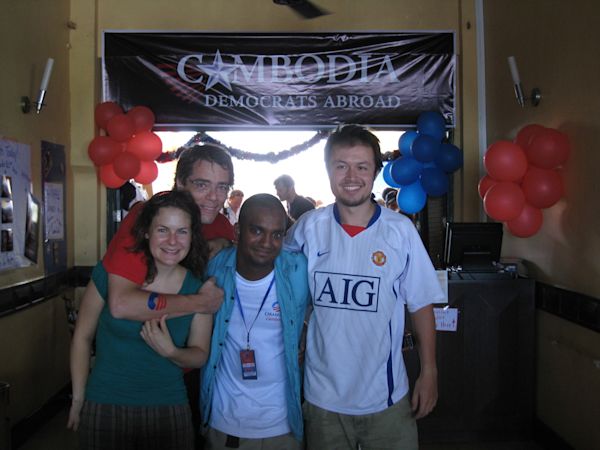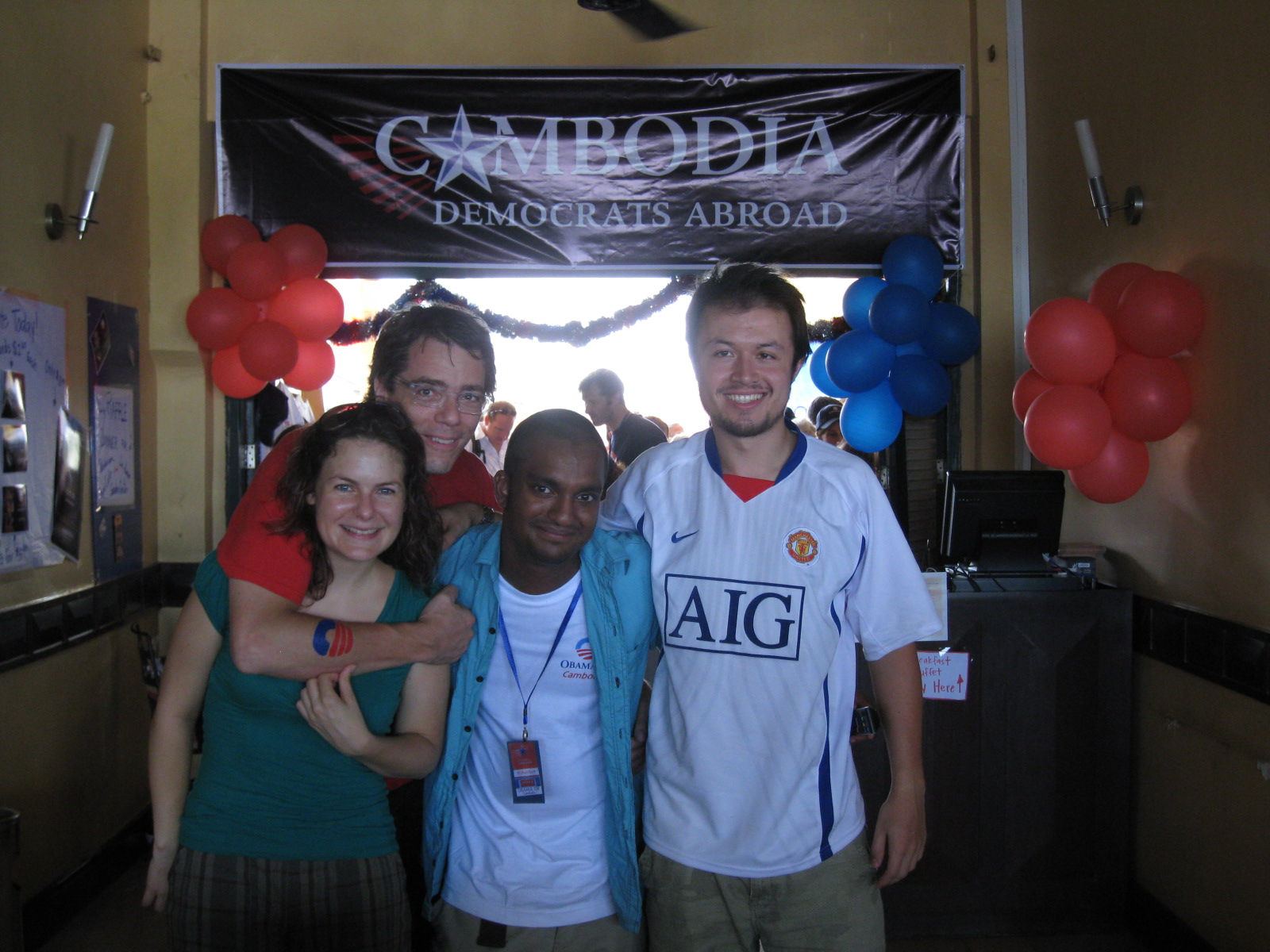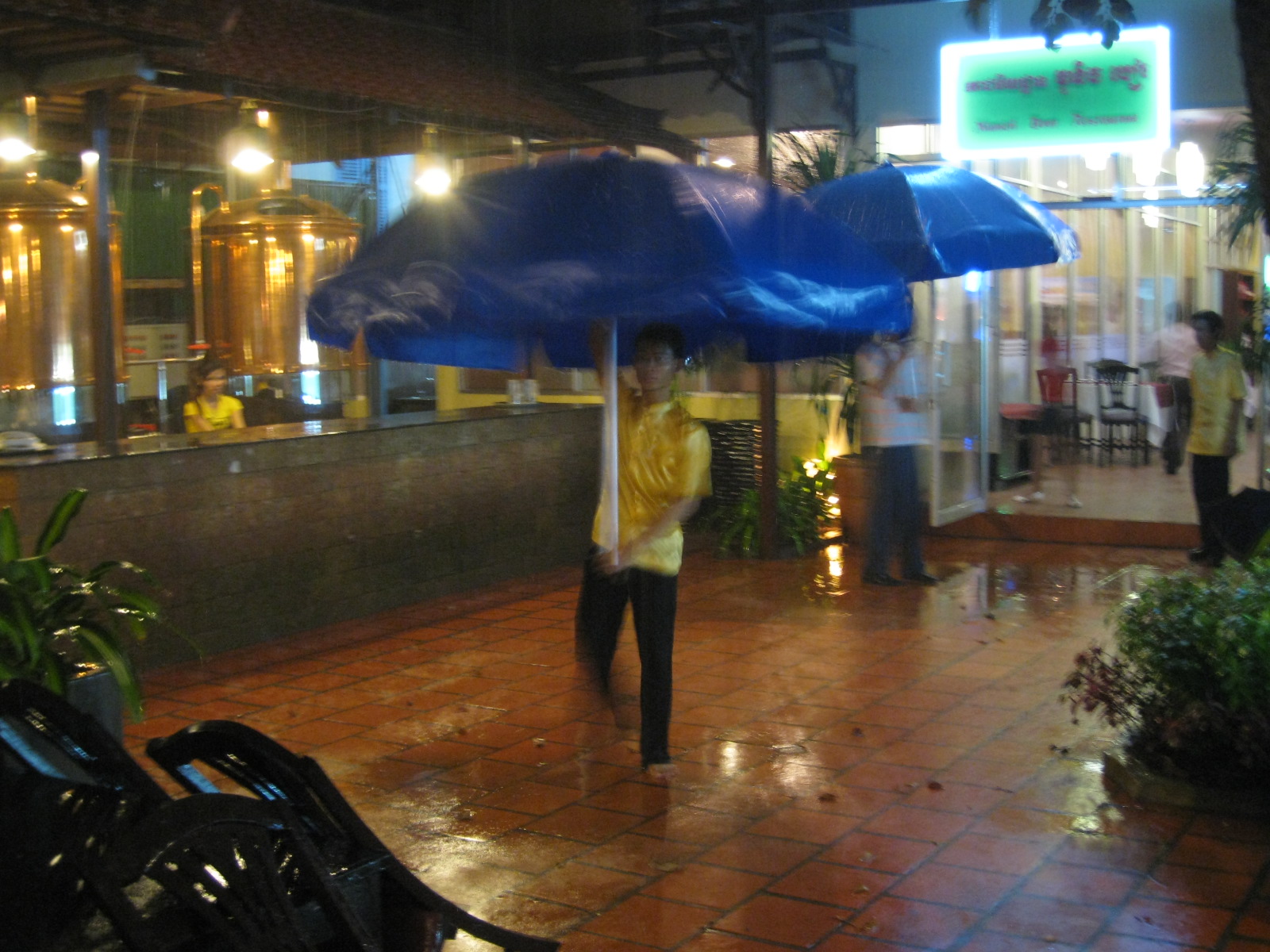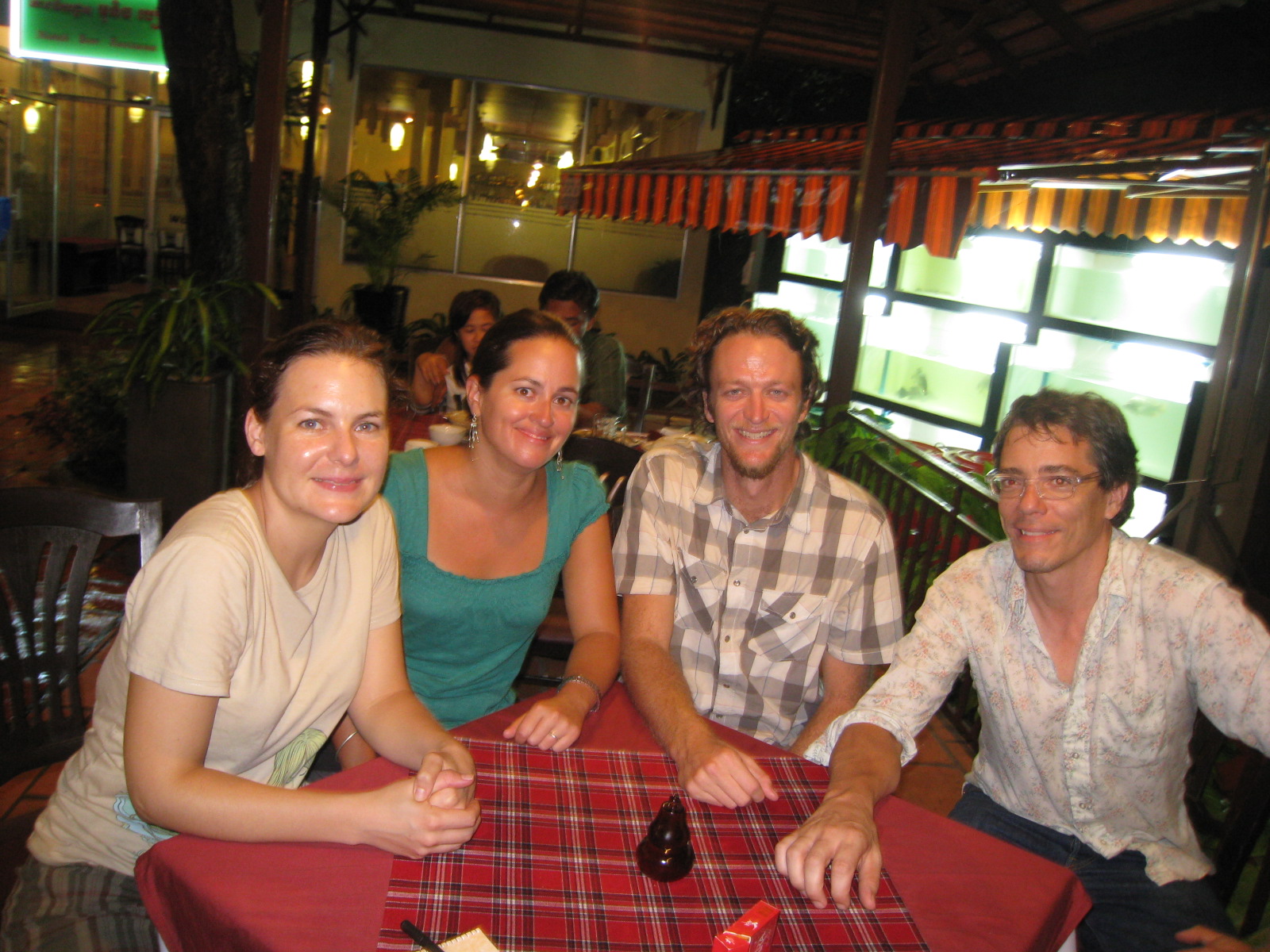
Wow, this Kiva world is small. The other day, while I was attending a United States Presidential election-day event with a good portion of the other expats in Phnom Penh, Cambodia, I noticed a woman just as teary-eyed as me as the results rolled in for President Elect Barack Obama. Both overwhelmed with emotion, we gave each other a hug out of pure joy. Then we just started talking, launching into a familiar round of questions you ask when you live or travel abroad.

Kiva Fellows at the Foreign Correspondence Club in Phnom Penh (left to right): Teresa Dunbar, John Briggs, Sanjaya Punyasena, Kieran Ball
“So are you traveling or do you live here?” “Where are you from?” “Where have you traveled?” “Do you recommend any countries or cities to visit?” “Are you traveling by yourself?”
After about 15 minutes into the conversation, the question that might have opened it all is asked. “Oh, and by the way, what’s your name?”
We introduce ourselves to each other. Her name is Erica, and she’s traveling with her husband Joe. Erica asks me, “So what are you doing here in Cambodia?”
I say, “I am a Kiva Fellow. Have you ever heard of Kiva?”
I’m about to give her my 10-second Kiva pitch, but she beats me to the punch and says, “Of course, my husband and I are Kiva lenders.”
Completely surprised, I say, “Wow, really? How long have you been lending on Kiva?” I’m expecting they’ve been lending for six months or less, since Kiva has only been around for about three years, and is such a young organization.
She says, “Since about 2006, I think.”
Surprised even more I ask, “How did you hear about Kiva back then?”
“We saw a piece on Frontline, and have been lending ever since,” she replies.
When Erica and Joe first visited kiva.org in 2006, they found that all the loans had been funded. But they persisted and revisited the site a week or two later, lending their first $25. Since making their first loan, they have made more loans. As the loans are repaid by Kiva-funded borrowers, they have re-lent all the money that Kiva has credited back to them – so far their money has been through at least two or three cycles of loan funding and repayment.
So — a Kiva Fellow meeting a Kiva lender somewhere like Cambodia. What are the odds are of this happening? If there are 6.72 billion people in the world (per Wikipedia), and there are about 360,000 Kiva lenders, then the odds of me meeting a Kiva lender are about 1 in 18,611, but I think the odds of a Kiva Fellow meeting a Kiva Lender are more like 1 in 14.4 million. Then again, since I’m a very social person, let’s just put the odds at 1 in 15,000 or 1 in 14 million.
Not so accurate back-of-the-napkin statistics aside, my point is that our meeting seemed like a rare thing. So I thought is I’d take the opportunity to ask Erica and Joe if I could interview them for the Kiva Fellows’ blog. They graciously agreed.
Erica had mentioned that she and Joe were not feeling well the day of the elections. They had caught some nasty bug, and I offered any help or advice on Cambodian medical facilities I could since I had been sick not so long ago. We emailed back and forth a few times, checking to see if they needed anything, but eventually they recovered and we went out a few nights later.
The weather was perfect since it was the tail end of the rainy season, and we opted for a low-key night of art, food, and conversation. We met up at The Meta House which is an art gallery/ movie house, and enjoyed a series of short films. After that, we headed to a lovely outdoor restaurant quiet enough for me to hassle them with questions.
Erica and Joe left Brooklyn behind in June to travel around the world for a year. So far they’ve been through parts of Africa, and India, and Thailand, and are now traveling through Southeast Asia. When I met them, they were staying in Phnom Penh, Cambodia’s capital, for about a week. Prior to traveling, Erica worked in the non-profit sector with low-income housing initiatives, and Joe was a software engineer for an e-commerce company.
“How many borrowers do you think you’ve lent to over the years?” I asked them.
Humbly, they say, “We’ve lent to about 30-40 entrepreneurs,” without disclosing the amount of money they’ve lent.
Erica and Joe say that from the loans they’ve made, they have received about 5-6 journals, updates on borrowers posted by Kiva Fellows or partner MFI staff. While they don’t remember any journals distinctly, Erica and Joe say they find them interesting. However, they consider journals to be the icing on the Kiva cake, and not the reason they actually lend.
“So how do you choose who to lend to?” I asked next.
They said at first they started to lend to entrepreneurs that live in countries to which they had traveled. So they split their loans 50-50 between Latin America and Africa, and at the same time they split their loans 50-50 between men and women, to reflect their gender division as a couple.
Joe said for a while he was fond of trying to fund loans to completion, topping them up and enjoying the moment when the loan is completely funded. However, that’s more difficult to do now on Kiva because loans are completed more quickly, and because of a $25 per-lender cap. Now Erica and Joe just want to keep as much of their money lent out as possible, so they can continue to have an impact.
When I asked why they lend, Erica and Joe said that they simply to want help effect positive change in the world. They said that when they’d traveled in Latin America and Africa and talked with people who owned businesses, they heard many stories of how people were being charged very high interest rates by moneylenders. When they heard of Kiva on Frontline, they thought of the small business owners being taken advantage of, and thought that lending through Kiva could provide a great alternative for entrepreneurs in the developing world who needed loans
Erica stressed how she appreciated the difference between what Kiva does and what many charitable and philanthropic organizations do. Access to money from Kiva for developing world entrepreneurs is simply faster, and hopefully easier, for them to get.
Kiva money is channeled through partner microfinance institutions (MFIs). MFIs require all loan applicants to fill out an application, and requirements for Kiva-funded applicants pose little additional burden – a photo, and a follow-up interview. So for entrepreneurs, great effort isn’t needed to get a Kiva-funded loan, and they are able to use their time to get done what they need to do.
This is something philanthropy just doesn’t seem to know how to do, with its numerous application forms and individualized reports that each foundation and lending body requires. They ultimately keep the person from doing what they were given the money to do, which is just not a good use of the person’s time and a drain on financial resources for everyone.
While we sat, a late night monsoon rain hit. We headed for a covered area of the restaurant, and continued our conversation in between moments of shared laughter with the waitstaff of the restaurant as we watched them maneuver between puddles, trying not to get to wet. They were quite skillful and resourceful.
While Erica and Joe are the first Kiva lenders I’ve met by chance since I’ve been a Kiva Fellow in Cambodia, I’ve met others here. Since the MFI I work with is Kiva’s oldest field partner in Southeast Asia, they have received a few requests from lenders to visit borrowers they have lent to. The MFI is open to the idea, so when a Kiva lender made a request a few months ago, the MFI agreed, and we took the lender into the village to meet the borrower he lent to.
With that story in mind, I had to ask Erica and Joe if they had a desire to ever meet the entrepreneurs they’ve lent to, especially since they could do so while traveling around the world. Their answer was a quick and firm, “No.” But, they also feel that their answer might not reflect what most lenders would say.
Erica said she thought such visits would be a drain on MFIs financial and staffing resources. Moreover, she said that borrowers would likely become overwhelmed, depending on how many lenders came to see them, and that the visits would take the borrower away from his or her work. Erica and Joe said that the money it would take to travel and visit borrowers would be better used on Kiva to fund more loans.
I had so many questions for them, but it was getting late in the evening. And the torrential rain was finally pausing, providing us an opportunity to get home without getting soaked. So I asked one last question, quickly.
“Would you consider taking your money out of Kiva since the economy is doing so poorly?” I asked.
“No,” they said, after thinking it over a bit.
Erica and Joe said that they would only withdraw their money from Kiva if things got really dire — if they really, really needed it. But they just do not foresee themselves needing the funds more than the people to whom they lend.
We finished our food and drinks and paid our bill. As we parted, we wished each other happy travels. I hope Erica and Joe are enjoying their travels, and are doing so in good health. From what they told me, I think they might be in Vietnam about now. I wonder if they’ll meet up with any other Kiva fellows along the way? What would the odds of that be?
/>
















